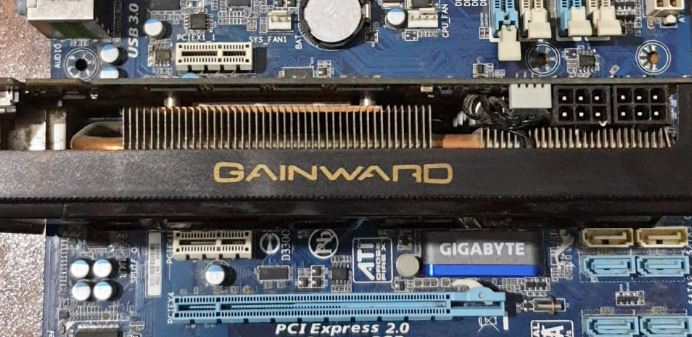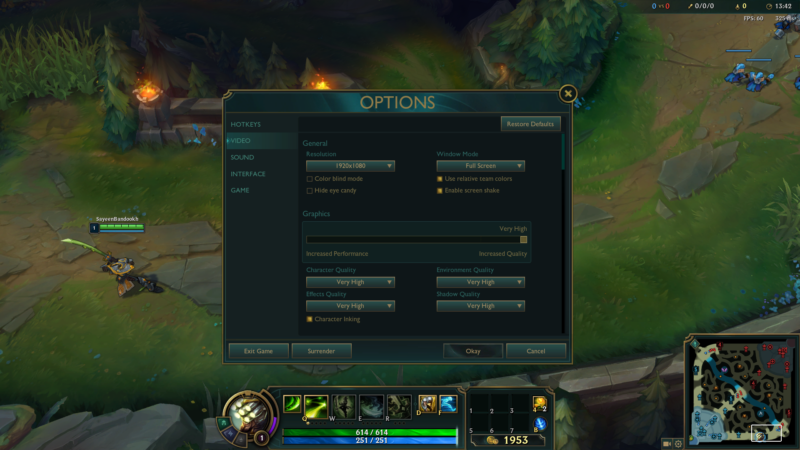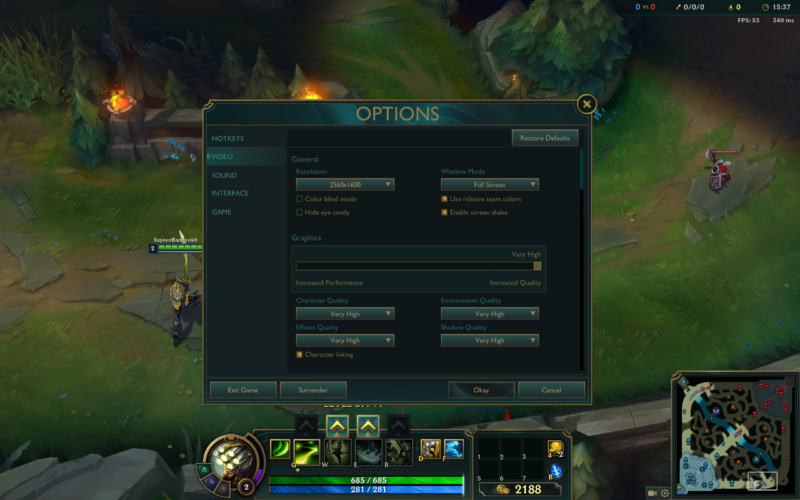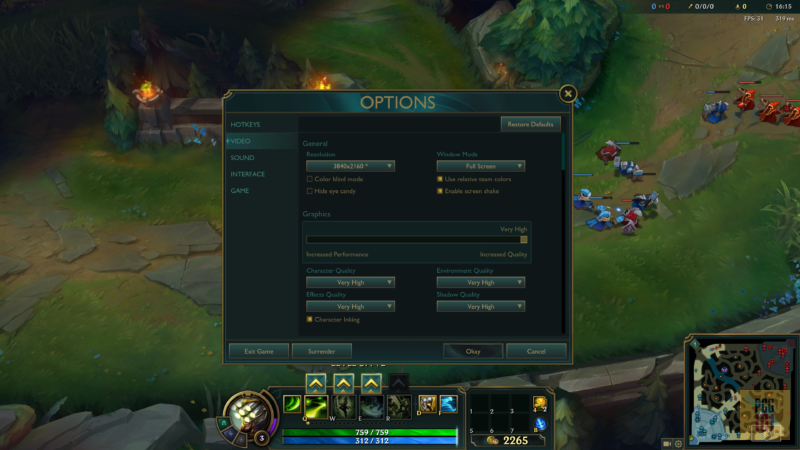League of Legends is one of the lightest games you can ever play on a PC. The system and the PC hardware you require to run this game are among the weakest.
In other words, the game is designed to be played even on a simple potato PC. Regarding needing a graphics card for League of Legends, the simple answer is NO; you do not need a DEDICATED graphics card to run this game.
Any good INTEGRATED graphics card released within the last decade would be sufficient to run this game without hiccups.
This makes sense because League of Legends is a popular MOBA game designed to be played by the masses. Since not everyone can afford top-of-the-line gaming specs, League of Legends has purposefully been designed to be supported by most systems that do not even have a dedicated graphics card.
I’ll explain in detail the graphics card requirements of League of Legends. However, first, let us talk about the difference between an integrated and a dedicated graphics card.
TABLE OF CONTENTS
Integrated vs. Dedicated Graphics Cards
You must understand the difference between the two. While they share the same primary purpose, they vastly differ in price and performance.
All PCs need a graphics processing unit (GPU) for the primary display functionality. No GPU = no display.
Integrated graphics cards, as the name suggests, are GPUs that are found built into the CPU chip itself. These are a cheaper alternative and are designed for basic computing.

Dedicated graphics cards are powerful standalone components that significantly raise the graphics processing prowess of your PC. These are designed for professionals in general and gamers in particular.
We refer to the dedicated graphics card when we ask whether a game like League of Legends requires a graphics card.
So Do You Need a Graphics Card for League of Legends?
To gauge whether League of Legends requires a dedicated graphics card or not, we first have to see what the system requirements of the game are:
According to the official system requirements, the game requires the following:
| Minimum GPU Requirements | Shader version 2.0b-capable |
| Recommended GPU Requirements | Nvidia GeForce 8800 AMD Radeon HD 5670 |
While the minimum requirements may seem confusing, they point out that this game can be played on almost any PC.
But even if you take the recommended requirements as the baseline, a PC over half a decade old is sufficient for supporting this game WITHOUT a dedicated graphics card.
The recommended dedicated NVIDIA GeForce 8800, now obsolete, was released in 2007; the Radeon HD 5670 was released in 2010. If more than decade-old hardware is sufficient to run the game at recommended levels, then the hardware TODAY would far exceed its requirements.
This leads us to the obvious next question:
Can You Run League of Legends on an Integrated Graphics Card?
We can put this differently: are integrated graphics cards today as powerful as the specified recommended GPUs released more than a decade ago?
The answer is certainly affirmative, as the following table proves:
| CPU | Release Year | G3D Mark | Class |
| Nvidia GeForce 8800 (GTX) – as per recommended specs | 2007 | 604 | Obsolete High-End GPU of Its Time (MSRP $599) |
| AMD Radeon HD 5670 –as per recommended specs | 2010 | 783 | Obsolete budget GPU of its time (MSRP $100) |
| Nvidia GeForce GT 710 | 2016 | 637 | Entry-Level Dedicated Graphics Card ($45) |
| Intel HD 630 | 2016 | 1148 | iGPU – found on 7th Gen Intel CPUs. |
| Intel UHD 630 | 2017 | 1386 | iGPU – as found on 8th – 10th Gen Intel CPUs |
| Intel UHD 750 | 2020 | 1684 | iGPU – as found on Intel 11th Gen CPUs |
| Intel UHD 770 | 2020 | 2428 | iGPU – as found on Intel 12th and 13th Gen CPUs |
| Nvidia GeForce GT 1030 | 2018 | 2613 | Entry-Level ($79) |
| AMD Radeon RX 550 | 2015 | 2764 | Entry-Level ($79) |
| AMD Radeon RX 560 | 2017 | 3631 | Lower-Mid ($99) |
| NVIDIA GeForce GTX 1050 | 2016 | 5202 | Lower-Mid ($109) |
| Nvidia GeForce RTX 4090 | 2022 | 39,009 | Top of the Line (MSRP 1599.99 USD) |
The table above uses the G3DMark scores obtained from videocardbenchmark.net to compare the LoL-recommended graphics cards with the current-gen iGPUs and dedicated graphics cards.
You can see how far the recent top-of-the-line graphics cards have come. The flagship RTX 4090 is about 65 times as powerful as the recommended GTX 8800. Hence using an RTX 4090 for mere League of Legends is entirely out of the question.
Even the lowest category of the recently released dedicated graphics card would far exceed the game’s recommended requirements.
Therefore, the more exciting and valuable point is that even the integrated GPUs released over half a decade ago exceed the game’s recommended requirements.
Take the Intel HD 630 iGPU released with the Intel 7th Gen CPUs in 2016 as an example. Even an Intel HD 630 iGPU, a seemingly inferior and neglected iGPU, is twice as powerful as the recommended GeForce 8800 or the AMD HD 5670.
This all points to the fact that you CAN have a dedicated graphics card to enjoy League of Legends at high graphics.
Testing League of Legends on Intel HD 630 iGPU
To further prove that League of Legends does NOT require a dedicated graphics card, I tested the game on an Intel HD 630 iGPU (with Intel Core i7-7700HQ and 16GB DDR4 RAM).
I tested the game on Full HD resolution, Quad HD Resolution, and 4K resolution while maintaining VERY HIGH graphics settings.
The results were typical, as you’d expect. The game works perfectly on FHD and Quad HD resolution. Here are the results in detail:
Full HD and Very High Graphics Settings
The game maintained over 60 FPS while playing at Full HD and Very High graphics settings.

We can confidently conclude that even an Intel HD 630 suffices for Full HD League of Legends gaming.
For the majority of gamers, this would be sufficient.
Quad HD and Very High Graphics Settings
Few gaming enthusiasts want something crisper than FHD resolution, such as QHD. It goes without saying that the higher the resolution, the more taxing the graphics processing is and the more powerful a GPU you need.
Quad HD refers to 2560 x 1440 resolution, and QHD+ refers to 2560 x 1600. I tested the game on the latter.
Fortunately, even at this resolution, the game maintained about 50 FPS, which is still respectable.

4K/UHD and Very High Graphics Settings

4K/UHD is a very demanding resolution. This has four times as many pixels as compared to Full HD resolution. Unfortunately, at 4K, the Intel HD 630 reached its performance threshold and could only maintain 30FPS.
Dialing down the graphics settings could improve the FPS, but if you are an enthusiast wanting to play LoL at 4K resolution, you may have to go up a notch for your choice of GPU.
The more recent Intel UHD 750 or the UHD 770 integrated graphics cards would be sufficient to support this game at 4K again, proving that you DO NOT need a dedicated graphics card to play this game.
Final Words
The gist of the discussion is that League of Legends CAN be played WITHOUT a dedicated graphics card, and NO, you need a gaming PC to enjoy this game.
Any average PC intended for essential home use, school work, or office work that typically does not feature a dedicated GPU should be sufficient for supporting this game.
Frequently Asked Questions
1. What type of graphics card is recommended for playing League of Legends?
League of Legends is a relatively low-demand game in terms of graphics requirements. Therefore, most modern graphics cards should be able to handle it without issue. If you’re looking for a specific recommendation, a mid-range graphics card such as the Nvidia GeForce GTX 1050 or AMD Radeon RX 560 should be more than sufficient for playing League of Legends at high settings.
2. Can I use an older graphics card to play League of Legends?
It’s possible to use an older graphics card to play League of Legends, but it will depend on the specific card and its capabilities. If the card meets the minimum system requirements for League of Legends, it should be able to run the game, although you may need to adjust the graphics settings to get the best performance.
3. Is it worth buying a new graphics card just for playing League of Legends?
If you’re only planning on playing League of Legends, then it may not be worth investing in a high-end graphics card. As mentioned earlier, a mid-range graphics card should be more than sufficient for running the game at high settings. However, if you plan on playing more demanding games in the future or running other applications that require a more powerful graphics card, then it may be worth investing in a higher-end card.
4. What other factors should I consider when choosing a graphics card for League of Legends?
In addition to performance and price, you should also consider factors such as compatibility with your system’s motherboard, power requirements, and physical dimensions of the graphics card.
It’s also worth researching the specific card you’re interested in to see what other users have to say about its performance and reliability, as well as any potential issues or incompatibilities.
